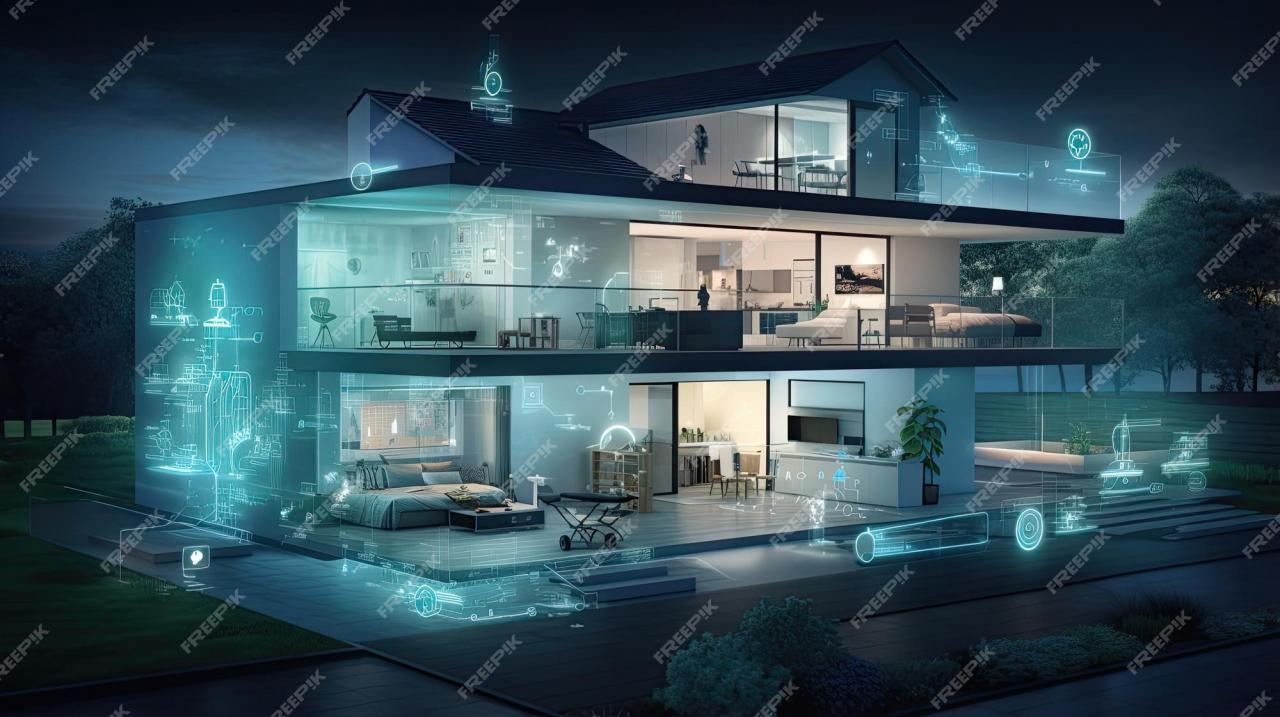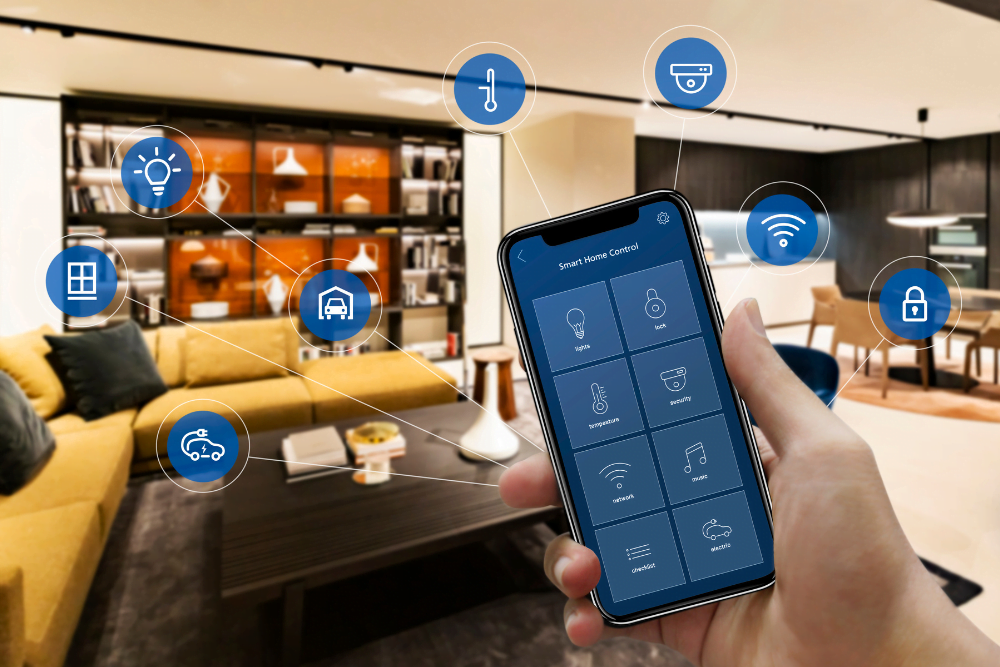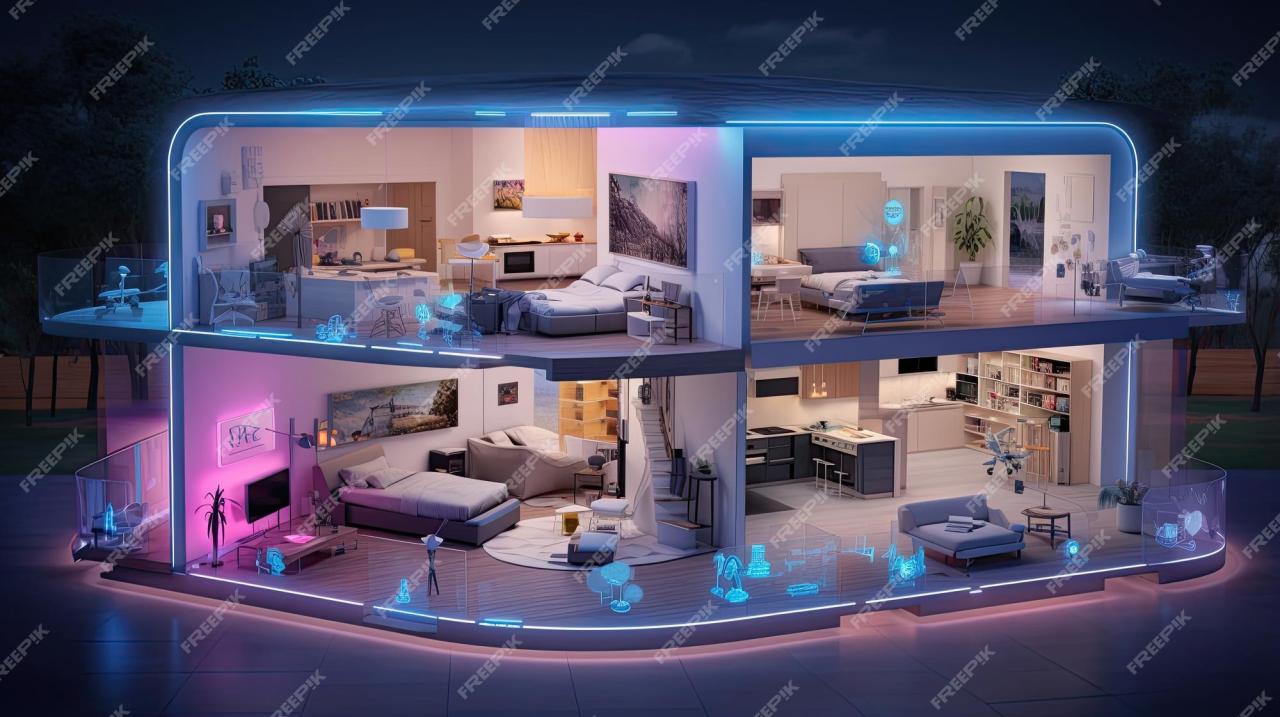Delving into the realm of smart device ecosystems for smart homes, this narrative unveils a world where interconnected systems pave the way for seamless living experiences. From essential components to future trends, this discussion promises to captivate and inform with a blend of casual formal language style and insightful analysis.
Exploring the key components and intricacies of smart home ecosystems, readers are in for a treat as they uncover the nuances of automation, interconnectivity, and user experience within this innovative landscape.
Introduction to Smart Device Ecosystem for Smart Homes
In the realm of smart homes, a smart device ecosystem refers to a network of interconnected devices that work together to provide automation, control, and convenience to homeowners. These devices can range from smart thermostats and lighting systems to security cameras and voice assistants, all seamlessly communicating with each other to enhance the overall living experience.
Importance of an Interconnected System
Having an interconnected system within a smart home is crucial as it allows for centralized control and automation of various functions. This means that users can easily manage and monitor different aspects of their home, such as temperature, lighting, security, and entertainment, all through a single interface.
The convenience and efficiency brought about by this interconnectedness streamline daily tasks and improve overall quality of life.
Benefits of a Well-Integrated Smart Device Ecosystem
- Enhanced Convenience: With a well-integrated smart device ecosystem, homeowners can remotely control and monitor their home environment, making it easier to adjust settings according to their preferences and schedules.
- Improved Energy Efficiency: Smart devices can work together to optimize energy usage by adjusting settings based on occupancy, weather conditions, and user behavior, resulting in cost savings and reduced environmental impact.
- Enhanced Security: Integrated security systems can provide real-time alerts and notifications, allowing homeowners to keep a close eye on their property and respond promptly to any potential threats or emergencies.
- Personalized Experience: By collecting and analyzing data from various devices, a smart device ecosystem can learn user habits and preferences, enabling customized automation and tailored experiences for each individual.
Key Components of a Smart Device Ecosystem

Smart homes rely on a variety of key components that work together seamlessly to create an efficient and connected ecosystem. These components include smart hubs, sensors, and smart devices, each playing a crucial role in ensuring a smooth and automated experience for users.
Smart Hubs
Smart hubs serve as the central point of control for various smart devices within a home. They act as a bridge, allowing different devices to communicate with each other and with the users through a single interface. Smart hubs are equipped with connectivity protocols such as Wi-Fi, Bluetooth, Zigbee, or Z-Wave, enabling them to interact with a wide range of devices.
By consolidating control, smart hubs simplify the management of multiple devices and enhance the overall user experience.
Sensors
Sensors are essential components that collect data from the environment or specific devices within a smart home. These sensors can detect motion, temperature, light, humidity, and more, providing valuable information that helps automate processes and optimize energy usage. For example, motion sensors can trigger lights to turn on when someone enters a room, while temperature sensors can adjust the thermostat to maintain a comfortable environment.
By integrating sensors into the ecosystem, smart homes become more responsive and efficient.
Smart Devices
Smart devices encompass a wide range of interconnected gadgets that offer advanced functionality and connectivity. These devices include smart thermostats, smart lights, smart locks, smart cameras, and more, all designed to enhance convenience, security, and energy efficiency within a smart home.
Smart devices can be controlled remotely through mobile apps or voice commands, allowing users to monitor and manage their homes from anywhere. By incorporating smart devices into the ecosystem, users can enjoy a more personalized and automated living experience.Overall, these key components work in harmony to create a smart device ecosystem that simplifies daily tasks, enhances comfort, and improves overall quality of life for users in a smart home setting.
Interconnectivity and Communication Protocols
Interconnectivity and communication protocols play a crucial role in enabling smart devices to work together seamlessly within a smart home ecosystem. Different communication protocols are used to ensure effective communication between devices, allowing them to exchange data and commands efficiently.
Zigbee
Zigbee is a low-power, short-range wireless communication protocol commonly used in smart home devices. It operates on the IEEE 802.15.4 standard and is known for its low power consumption, making it ideal for battery-operated devices like sensors and smart bulbs.
Zigbee creates self-organizing mesh networks, allowing devices to relay messages through multiple nodes to extend the range.
Z-Wave
Z-Wave is another wireless communication protocol designed specifically for smart home devices. It operates on the sub-1 GHz frequency band, offering longer range compared to Zigbee. Z-Wave devices create a mesh network as well, enabling reliable communication between devices even if they are out of direct range of the hub.
Z-Wave is known for its interoperability, with devices from different manufacturers able to communicate with each other.
Wi-Fi
Wi-Fi is a widely-used communication protocol in smart homes due to its high data transfer speeds and widespread availability. Wi-Fi enables smart devices to connect directly to the home network, allowing for seamless integration with other devices and access to the internet.
While Wi-Fi offers fast speeds, it can be more power-hungry compared to protocols like Zigbee and Z-Wave.
Bluetooth
Bluetooth is another popular communication protocol used in smart devices, especially for connecting devices like smartphones, speakers, and wearables. Bluetooth offers short-range communication, making it suitable for devices in close proximity to each other. Bluetooth Low Energy (BLE) is commonly used in smart home devices due to its low power consumption and ability to run on coin cell batteries for extended periods.Effective interconnectivity between smart devices is essential for creating a seamless smart home experience.
Devices need to be able to communicate with each other regardless of the communication protocol they use. Compatibility between different protocols and devices is crucial for ensuring that all components of a smart home ecosystem work together harmoniously.
Automation and Control Features
Automation plays a crucial role in smart device ecosystems for smart homes, allowing for seamless control and management of various devices and systems. This feature enhances convenience, efficiency, and security within the home environment.
Automation Capabilities
Automation in a smart device ecosystem enables tasks to be performed automatically based on predefined conditions or triggers. For example, smart lights can be programmed to turn on/off at specific times or when motion is detected. This automation feature not only saves time but also contributes to energy efficiency by ensuring devices are only active when needed.
Examples of Automation in Smart Homes
- Smart thermostats adjusting the temperature based on occupancy and preferences, leading to energy savings.
- Automated door locks that can be remotely controlled and monitored for enhanced security.
- Smart irrigation systems adjusting watering schedules based on weather forecasts to optimize water usage.
Control and Customization
Users can control and customize automated features through smart home hubs or apps on their smartphones or tablets. These platforms provide a centralized interface to manage and adjust settings for various devices. For instance, users can create personalized schedules, set triggers for automation, and receive notifications or alerts for any unusual activity.
This level of control allows users to tailor their smart home experience to suit their preferences and lifestyle.
Data Privacy and Security Measures

In a smart device ecosystem for smart homes, data privacy and security are paramount to protect sensitive information and prevent unauthorized access.
Encryption and Authentication Protocols
Encryption and authentication protocols play a crucial role in safeguarding sensitive information within a smart home environment. Encryption involves encoding data in such a way that only authorized parties can access it, while authentication ensures that only trusted users can interact with the system.
- Use strong, unique passwords for all smart devices and networks to prevent unauthorized access.
- Enable two-factor authentication whenever possible to add an extra layer of security to your devices.
- Regularly update the firmware of your smart devices to patch any security vulnerabilities.
- Monitor your network for any suspicious activity and consider setting up a separate network for your smart devices.
Integration with Voice Assistants

Voice assistants like Alexa, Google Assistant, and Siri have revolutionized the way we interact with our smart devices. By integrating these voice-controlled assistants into smart device ecosystems, users can enjoy a seamless and convenient smart home experience.
Benefits of Voice-controlled Smart Homes
- Hands-free operation: Users can control various devices in their smart home simply by using voice commands, eliminating the need to manually operate each device.
- Convenience: Voice assistants make it easier to perform tasks like adjusting the thermostat, turning off lights, or playing music, all with a simple voice command.
- Accessibility: Voice-controlled smart homes are especially beneficial for individuals with mobility issues or disabilities, providing them with greater independence and control over their surroundings.
- Integration: Voice assistants can be integrated with a wide range of smart devices, allowing users to create a customized and interconnected ecosystem tailored to their needs.
Tasks Accomplished Using Voice Commands
- Adjusting lighting and controlling smart bulbs.
- Setting the temperature on smart thermostats.
- Playing music or streaming audio through smart speakers.
- Creating reminders, shopping lists, or calendar events.
- Checking the status of connected devices or appliances.
User Experience and Interface Design
User experience plays a crucial role in the successful implementation of smart home ecosystems. A seamless and intuitive interface design can greatly enhance the usability and effectiveness of smart devices in a connected environment.
User-Friendly Interfaces for Controlling and Monitoring Smart Devices
User-friendly interfaces are essential for enabling homeowners to easily control and monitor their smart devices. This includes intuitive dashboard layouts, clear navigation menus, and straightforward controls that provide quick access to essential functions. Visual indicators and notifications can also help users stay informed about the status of their devices and any alerts that require attention.
- Dashboard Layout: A well-organized dashboard displaying all connected devices and their current status can help users quickly assess and control their smart home environment.
- Navigation Menus: Clear and simple navigation menus allow users to easily access different features and settings within the smart home ecosystem.
- Straightforward Controls: Intuitive controls, such as sliders, buttons, and toggles, make it easy for users to adjust settings and preferences without confusion.
- Visual Indicators: Visual cues like color-coding and icons can convey important information at a glance, enhancing the user experience.
- Notifications: Timely alerts and notifications keep users informed about device status, energy consumption, security alerts, and other relevant updates.
Role of App Design and Usability
The design and usability of mobile apps are critical components of the overall user experience in smart home ecosystems. Well-designed apps provide a seamless interface for users to interact with their devices, set up automation routines, and monitor their home remotely.
- Responsive Design: Apps should be optimized for various screen sizes and devices to ensure a consistent user experience across platforms.
- Intuitive Navigation: Clear menus, buttons, and gestures help users easily find the features they need and navigate within the app efficiently.
- Personalization Options: Customizable settings and preferences allow users to tailor the app interface to their specific needs and preferences.
- Remote Access: Apps with remote access capabilities enable users to control and monitor their smart devices from anywhere, providing convenience and peace of mind.
- Feedback Mechanisms: User feedback and reviews can help developers identify areas for improvement in app design and functionality, leading to continuous enhancements for a better user experience.
Future Trends and Innovations
The future of smart device ecosystems for smart homes is an exciting realm filled with possibilities for innovation and advancement. Let's explore some of the predicted trends and upcoming technologies that could revolutionize the way we interact with smart devices.
Advancements in AI
Artificial Intelligence (AI) is expected to play a significant role in shaping the future of smart home technology. With advancements in machine learning and natural language processing, AI-powered smart devices will become more intuitive and capable of understanding and responding to human commands and preferences in a more personalized manner.
IoT Integration
The Internet of Things (IoT) will continue to expand and evolve, allowing for seamless connectivity between various smart devices within a home ecosystem. This interconnected network of devices will enable enhanced automation, data sharing, and communication, resulting in a more efficient and convenient smart home experience.
Enhanced User Interfaces
Future smart devices are expected to feature more intuitive and user-friendly interfaces, making it easier for homeowners to interact with and control their devices. Touchless controls, gesture recognition, and enhanced visual displays are just some of the innovations that will enhance the overall user experience.
Energy Efficiency Solutions
As sustainability becomes an increasingly important focus, future smart devices will incorporate energy-efficient technologies to help homeowners reduce their carbon footprint and lower energy costs. Smart thermostats, lighting controls, and appliances will become even more efficient and environmentally friendly.
Security and Privacy Enhancements
With the growing concern over data privacy and cybersecurity, future smart device ecosystems will prioritize enhanced security measures to protect user information and prevent unauthorized access. Features such as end-to-end encryption, biometric authentication, and secure communication protocols will be essential components of next-generation smart home systems.
Ending Remarks
As we conclude this exploration of smart device ecosystems for smart homes, it's evident that the future holds boundless possibilities for enhancing our living spaces. From enhanced automation to advanced security measures, the journey towards smarter homes continues to evolve, promising a future where convenience and innovation intersect seamlessly.
Q&A
What are the main components of a smart device ecosystem?
The main components include smart hubs, sensors, and various smart devices that work together to create a connected ecosystem within a smart home.
How do communication protocols impact smart home devices?
Communication protocols like Zigbee, Z-Wave, Wi-Fi, and Bluetooth play a crucial role in ensuring seamless connectivity and effective communication among smart devices in a home environment.
Why is data privacy important in a smart device ecosystem?
Data privacy is vital to protect sensitive information within a smart home setup, and encryption and authentication protocols help safeguard data from cyber threats.